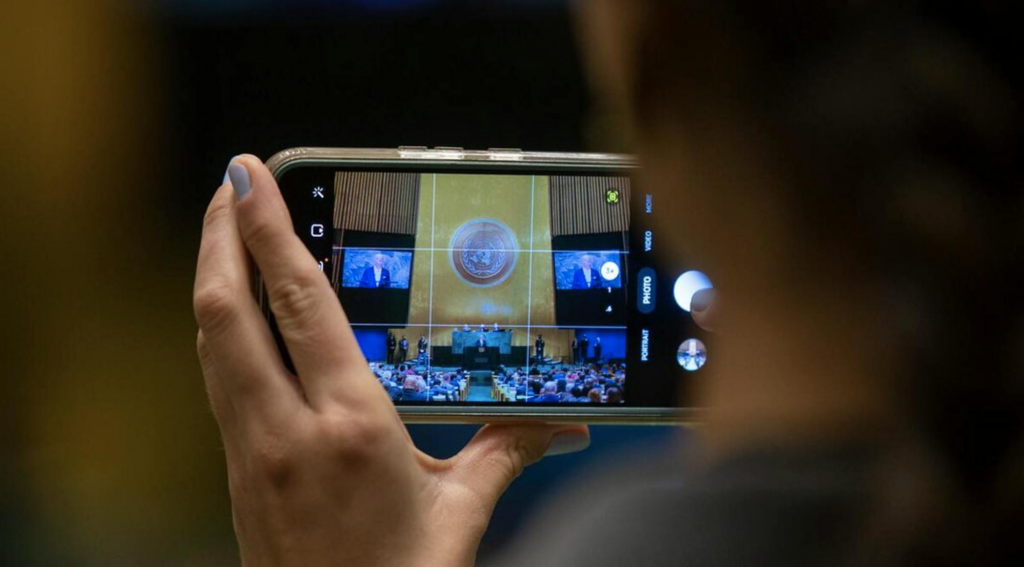
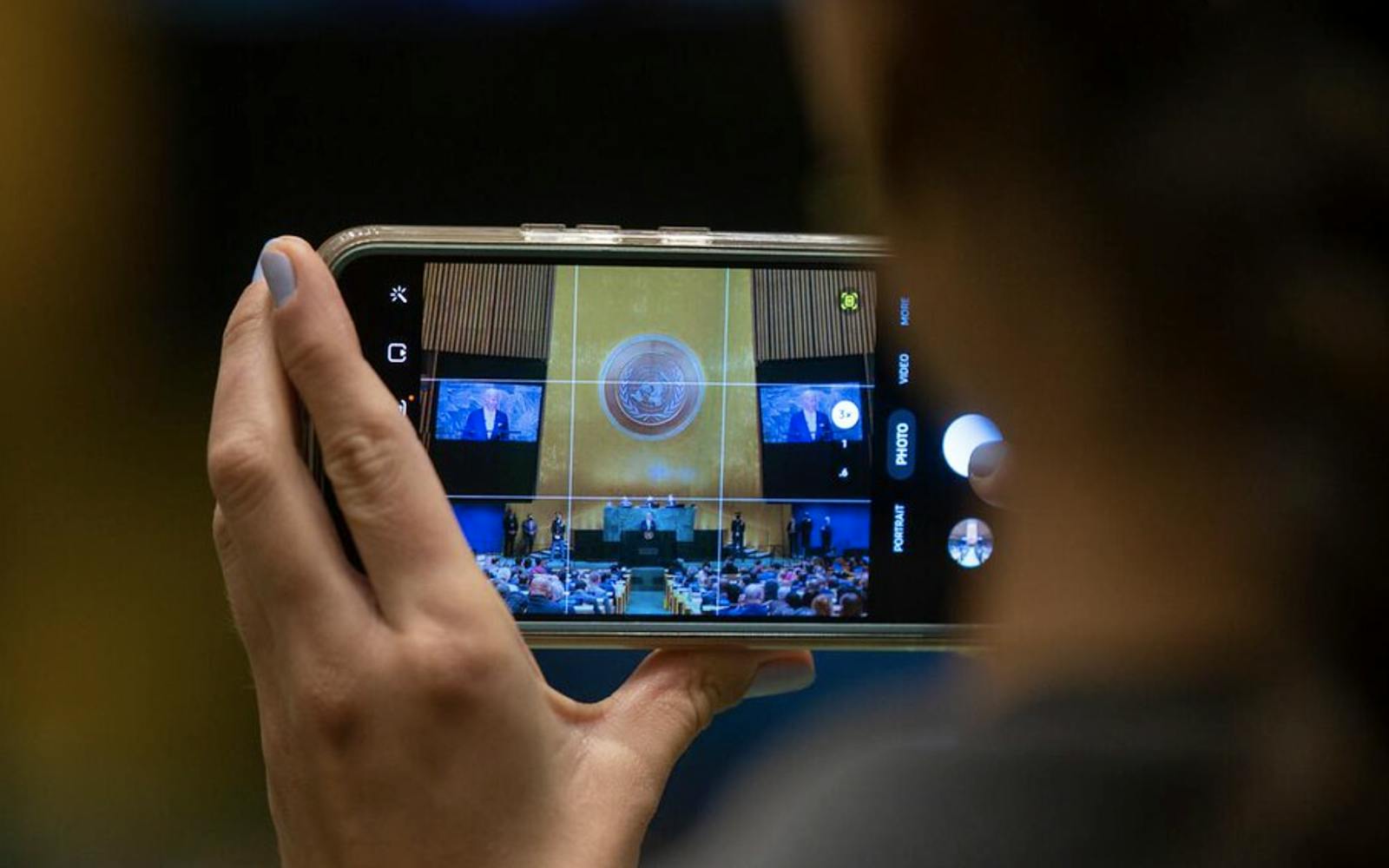
A view of the UN General Assembly Hall. Leaders from around the world will step up to the podium for the General Debate during High-Level Week of the 79th Session of the UN General Assembly. Photo: UN/Cia Pak
The UN’s mission is more important than ever, which is why calls for bold changes to the 1940s-era institution are growing louder. With the UN General Assembly fast approaching, here’s what leaders and experts across the UN Foundation are following, and what this year’s convening could mean for the future of multilateralism and the fate of the world.
It’s the biggest diplomatic event on the calendar. Held each September, the annual gathering of the UN General Assembly (UNGA) brings together world leaders and representatives from all 193 Member States, along with thousands of problem-solvers and passionate, engaged citizens for what’s known as High-level Week. This year’s convening — the institution’s 79th — feels especially consequential.
“The UN is a unique institution, and, perhaps more than ever in its nearly 80 years, is facing an inflection point,” says Michelle Milford Morse, Vice President for Girls and Women Strategy. “This is an extraordinary moment in its history for a genuine reckoning on how the UN should be fit for purpose and fit for our future.”
From sea-level rise to antimicrobial resistance, UNGA 79 will tackle a broad range of challenges that can’t be solved by one nation alone. UNGA High-level Week kicks off on Sept. 24 this year, preceded by the two-day Summit of the Future. There, Member States are expected to outline ways the UN can adapt to meet emerging issues, from closing the digital divide and artificial intelligence to more equitable financing for low-income countries.
While all of the planet’s problems won’t be solved during these few short weeks, debates and conversations at UNGA 79 could set the stage for solutions to devastating global trends.
“Not talking about our challenges does nothing to solve them,” says Caroline Kleinfox, Director of U.S. SDG Policy Planning, rebutting criticism that the global convening amounts to little more than talk behind closed doors.
Dr. Ahmed Ogwell, Vice President of Global Health Strategy, agrees. “We don’t choose our neighbors, but when we are faced with challenges, it is our neighbors that we have to work with,” he says. “UNGA is neighbors coming together to try and address shared challenges.”
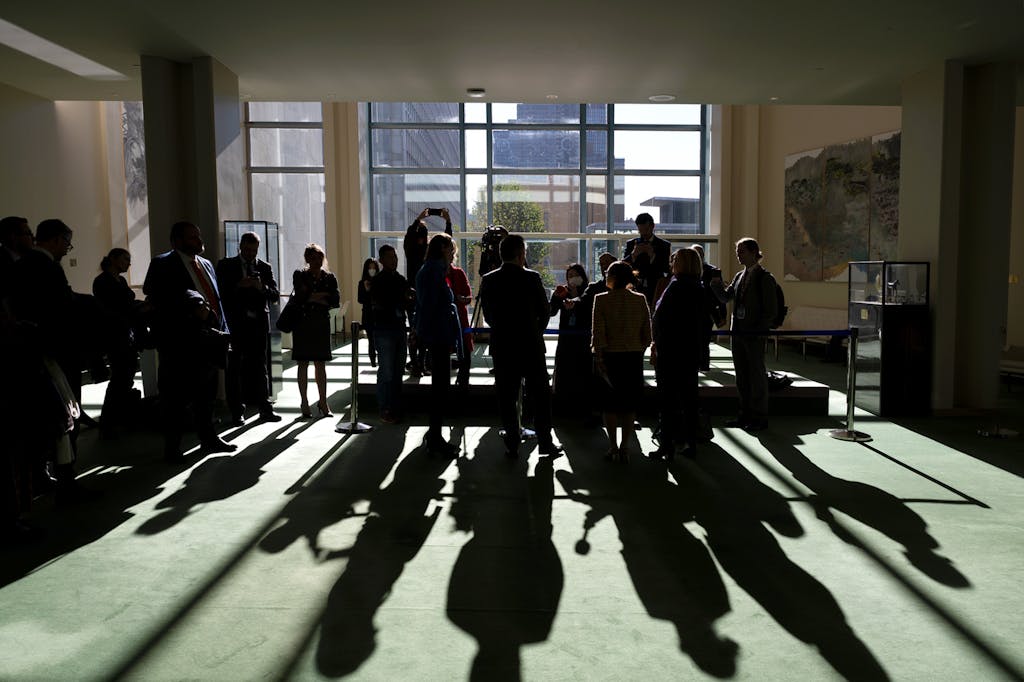
People gather at UN Headquarters in New York City, where thousands of world leaders, activists, and advocates of all ages will soon come together for the 79th Session of the UN General Assembly. Photo: UN/Manuel Elías
THE UN’S EVERYDAY IMPACT
“It’s easy to forget that the UN is actually working in many vital, if unseen, ways,” says Harshani Dharmadasa, Senior Director for Global Partnerships and Initiatives. In the face of simultaneous and prolonged disasters, the UN provides unparalleled humanitarian assistance to people in need across the globe. For example, the UN’s Office for the Coordination of Humanitarian Affairs reached 128 million people in need last year alone, while the World Food Programme feeds more than 150 million people each year and UNHCR, the UN Refugee Agency, offers shelter and support for millions of displaced people in 136 countries.
“Every day, somewhere, the UN is making a difference and saving lives,” says George Hampton, Executive Director for Global Policy and Multilateral Initiatives. “We need to remember that the UN isn’t a singular thing. It’s a collection of agencies and organizations, an interconnected global system that is taking on so many different challenges every day — and overcoming them. The UN is solving practical problems in people’s lives — both those that we see and those that we don’t.”
For nearly eight decades, the UN has brought countries together to overcome obstacles and achieve major wins for humanity — among them eradicating smallpox, shrinking the hole in the ozone layer, and accelerating the development and delivery of lifesaving COVID-19 vaccines.
“It is an expression of empathy, cooperation, and humanity, of how we work together to tackle some of the biggest problems that have no boundaries,” Harshani adds.
Though countries have already laid out a clear vision for the future through the Sustainable Development Goals (SDGs), the Paris Agreement, and other international frameworks, global cooperation needs to evolve to fulfill those promises.
“We have an international system that was built in the 1940s, and we’re trying to solve 21st-century problems with it,” says George. “Imagine: If you owned a car from the 1940s, you would be doing everything you could to bring it up to modern standards.”
Because the bottom line, as Julie Garfieldt Kofoed, Senior Director for Sustainable Development Initiatives, is this: “If the UN didn’t exist, we would have to invent it.”
While daunting, it’s a challenge we can meet. “Remember: The UN is not static,” says Michelle. “It has changed over time because people have cared enough to show up and be a part of it, and to push it to change when it needs to.”
It’s that faith in the indispensability of the UN and in its ability to evolve that is fueling momentum — and hopefully, will drive progress — when leaders meet at UNGA 79.

Young leaders participate in the Transforming Education Summit and the associated Mobilization Day during UNGA in 2022. These youth-led events focused on mobilizing young people, teachers, civil society, and other global stakeholders to support the transformation of education worldwide. Photo: UN/Paulo Filgueiras
THE SUMMIT OF THE FUTURE: RESET, RETHINK, REIMAGINE
At the Summit of the Future, Member States will come together and reach consensus on how to protect our present and safeguard our future. That consensus includes a plan, a negotiated Pact for the Future that will be adopted and that consists of two annexes: a Declaration on Future Generations and a Global Digital Compact. Together, they will address crucial issues ranging from financial reform to emergency preparedness to governance in outer space.
“There’s something about humanity that we can only think about now,” says Harshani. “It’s hard for us to think about next week or next month, let alone five, 10, 50, or 100 years ahead. So this is a moment where we’re trying to use the best of technology, the best of science, and the brightest minds to peer into the future.”
The Pact itself covers five key pillars: Financing for Development and the SDGs, Peace and Security, Science and Technology, Youth and Future Generations, and Transforming Global Governance. This includes a range of reforms and recommendations that cover the major topics and tests of our time from rethinking the UN Security Council and the UN Human Rights Council to overhauling our international financial system. As part of this reset moment, the Pact also seeks to unlock more resources to achieve the SDGs and address the global debt crisis, which has long held back developing economies.
Another core objective of the Pact will be establishing a new emergency protocol ahead of the next global shock. “The Emergency Platform, as it’s officially known, really came out of the Ukraine crisis and COVID-19,” George says. “Those events in particular showed that the world needed to change.”
NEW FRONTIERS IN CYBER AND OUTER SPACE
As we look to the future, harnessing the power of technology as a force for good remains paramount. That’s why the Pact lays out human rights–based principles and parameters for global cooperation across new frontiers in both cyber and outer space.
“We know our world is turning 100 times faster because of technology,” says Harshani. “But if we use technology for good, we can deliver on the SDGs, we can tackle the biggest challenges confronting humanity. That is the whole purpose of the Global Digital Compact.”
” If we use technology for good, we can deliver on the SDGs.”
Harshani Dharmadasa, Senior Director for Global Partnerships and Initiatives
The Compact addresses a range of issues that hinder connectivity and threaten safety and rights online, chief among them being closing the digital divide. There are over 5 billion internet users worldwide, representing about 67% of the global population, but access remains uneven: Only 27% of those living in least developed countries have internet access. While digital inclusion is paramount, so too is protecting users once they are online. To that end, the Compact also focuses on the application of human rights online, as well as providing people with options as to how their data is used, and introducing accountability criteria for discriminatory and misleading content.
But of all new technologies, perhaps none is evolving as fast as artificial intelligence. The Compact seeks to find intergovernmental agreement on how best to mitigate its risks while realizing its incredible potential to revolutionize our planet. “The idea is essentially to create an international, independent scientific body that will provide recommendations on AI governance for the future,” George says, likening the new agency as an “IPCC for AI,” referring to the Intergovernmental Panel on Climate Change, the UN’s independent climate body.
Another largely unregulated yet rapidly changing domain is outer space. From 1957 to 2012, an average of 150 satellites were launched annually into outer space. In 2022 alone, that number rose to almost 2,500.
Both cyber and outer space are perhaps two of the most clear examples of areas that demand global cooperation that cuts across sectors — from government to private companies to nongovernmental organizations and everyday citizens. “The world is too complicated to just have solutions lie on the shoulders of one entity anymore,” says George.
YOUNG PEOPLE AND THE FUTURE GENERATIONS
At the heart of the Pact is a clear focus on who this is for: young people alive today and the estimated 10 billion people expected to be born before the century ends.
“There are more people yet to be born this century than those alive today,” says Inés Yábar, Lead Next Generation Fellow.
She also points out that by 2100, almost half of the world’s young people will live in Africa, making it essential to think about the future with everyone in mind, not just those historically at the forefront of change. “All nations will inherit the consequences of the actions leaders take — or fail to take — today, with those who are currently the most marginalized already at a disadvantage,” she adds.
“We’re thinking beyond the Summit, because it’s really about next and future generations,” says Prachi Shevgaonkar, Next Generation India Fellows Lead. Both Inés and Prachi have noticed a positive shift in youth participation in UN spaces in recent years and will be looking to see more young faces in and around UNHQ this September.
This will also be the first UNGA since the UN’s Youth Office was established in 2023. The Office represents the institutionalization of young voices in the UN and a new model of intergenerational leadership.
“For me, this year is all about showing that the UN isn’t deaf to the voices of young people,” says Inés.
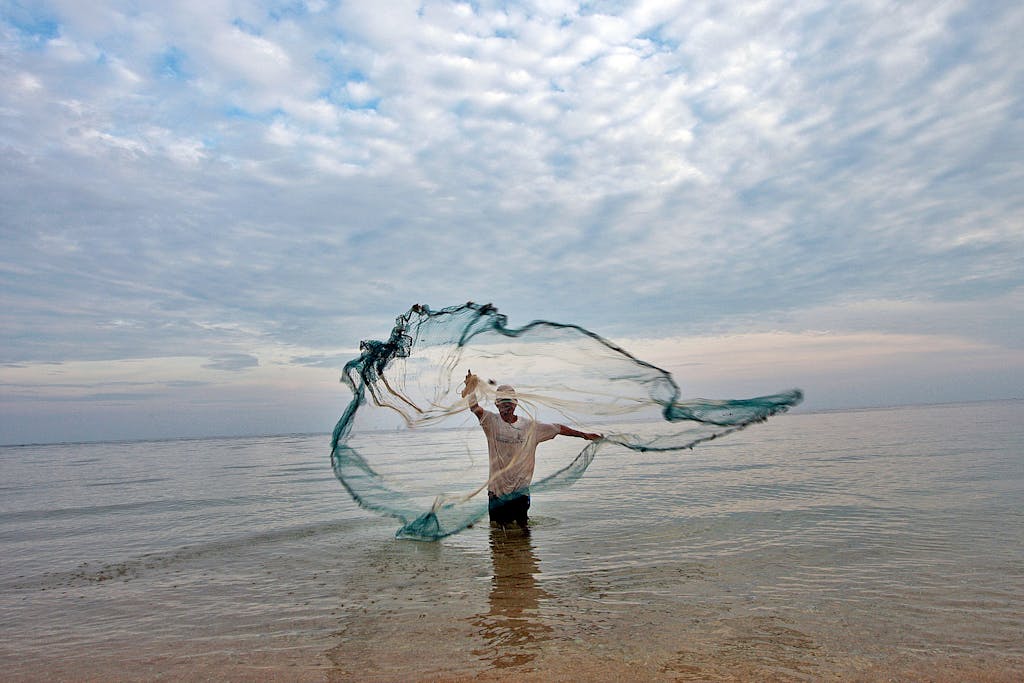
A fisherman along the Watabo’o beach in Timor-Leste casts a net in the water to catch small fish. Timor-Leste is located in a region of the Pacific where sea levels are rising at alarming rates, jeopardizing coastal communities and their livelihoods. Photo: UN/Martine Perret
Climate Change and Global Health at UNGA 79
High-Level Meetings will be held during UNGA 79 to shine a light on two often overlooked issues: the threat of rising sea levels, and what the World Health Organization has called a “silent pandemic” — antimicrobial resistance.
Antimicrobial resistance, or AMR, refers to pathogens like bacteria, viruses, fungi, or other parasites that have become resistant to antibiotics.
“It’s another pandemic, if you ask me,” says Ahmed. “It is growing, and it is costing us a lot.”
Trillions, in fact. According to the World Bank, AMR leads to an estimated $1 trillion in losses to global GDP every year.
And because AMR is multisectoral in nature — affecting both human and animal health in a destructive feedback loop — it demands cooperation across borders, industries, and sectors. In order to consider the meeting a success, Ahmed will be looking to see if Member States agree to quantifiable targets and a mechanism to monitor their implementation.
The second High-Level Meeting on the agenda confronts the threat posed by rising seas, which, as Julie explained, “is an existential crisis for some Member States.” For many island nations, failing to meet the target of limiting global warming to 1.5℃ over preindustrial temperatures would have dire consequences.
Pete Ogden, Vice President of Climate and Environment, says he will be watching for new climate commitments from leaders at UNGA, many of whom have historically used the podium in the General Assembly Hall as a platform to announce major climate action. “UNGA is still the only time when all world leaders come together, and it creates the right conditions for the kind of high-level political focus that climate change deserves,” he says.
Notably, leaders from the United Arab Emirates, Azerbaijan, and Brazil — the previous, current, and upcoming hosts of the annual UN Climate Change Conference (COP) — have pledged to kickstart the next round of talks on national reduction targets for greenhouse gas emissions at this year’s UNGA. Pete expects these announcements to generate a lot of attention and, hopefully, renewed global ambition. Talks in New York this September will pave the way for final negotiations on a new climate finance target at COP 29 in Azerbaijan this November.
And given the interconnected nature of climate and other development objectives, “the issue of climate finance will very much be a live discussion that cuts across a lot of the different issues that will be raised at UNGA 79,” Pete adds.
Among those cross-cutting issues is global health. Climate change and human health are inextricably linked, after all. As Ahmed says, “The face of climate change is the failure of health.”
MAKING SPACE FOR MORE VOICES AT UNGA 79
Amid growing calls for bolder ambition and urgent action from civil society, both UNGA 79 and the Summit of the Future seek to expand opportunities for activists and advocates of all ages to have a voice in shaping our international system, and call on leaders to deliver on promises made. Chief among those promises is to leave no one behind — a tenet central to the SDGs, which are in jeopardy. With only six years until the 2030 deadline, just 17% of the Goals are on track.
“It’s not just the importance, but the necessity of bringing all voices of society into these conversations, especially when you’re talking about the SDGs, where there is real and direct recognition of the fact that governments cannot — and should not — do this on their own,” says Julie.
Of all 17 SDGs, there’s one Goal in particular — SDG 5: Gender Equality — that Michelle wants to see renewed focus on at UNGA 79. “We say we want more peaceful, prosperous societies and more equality, and yet, we refuse to include women,” she says. “We refuse to take the needs and the rights of half our human family seriously enough to prioritize them.”
Explaining the folly of this intransigence, she adds, “It’s kind of like being desperate for guacamole, but refusing to go and get an avocado.”
Despite insufficient global progress on gender equality, Michelle notes that the UN is one of the only places where advocates from all over the globe can meet and make a joyful expression for equality. Given the UN’s unparalleled convening power, Michelle says she will be watching to see “the degree to which UNGA 79 answers the loud and persistent calls from civil society — and gender equality advocates, in particular — to let us in and to let us be heard.”
UNGA 79 and the Summit of the Future are both taking place in New York, but people everywhere can have a voice, take action, and get involved.
“Find a really simple point of entry to get started,” Caroline recommends. “There are so many ways to engage that go beyond the formal processes taking place in New York. It could be as simple as talking to your neighbors or your local elected officials about an issue you care about — it all goes up the chain.”
For its part, the UN is also encouraging people to take action — no matter how big or small — for our common future in their day-to-day lives. In fact, the UN’s ActNow campaign has rallied over 1 million people to act ahead of the Summit of the Future, bringing the total number of participants to a whopping 22 million and counting.
UN Foundation experts also point out that, ultimately, the most direct way to get involved and influence how leaders are showing up at the UN is to vote. UNGA 79 is being held during the biggest election year in human history with more than two-thirds of the global population holding national elections in 2024.
“We have the UN that Member States want,” George says, referring to the direct impact that elected national leaders have at the UN. “That means the elections this year — and how people participate in their own governments when and where they can — matters.”
Michelle underscores this point. “When we all vote, we give ourselves a chance to send to the halls of power leaders who reflect both our concerns and our deepest hopes,” she says.
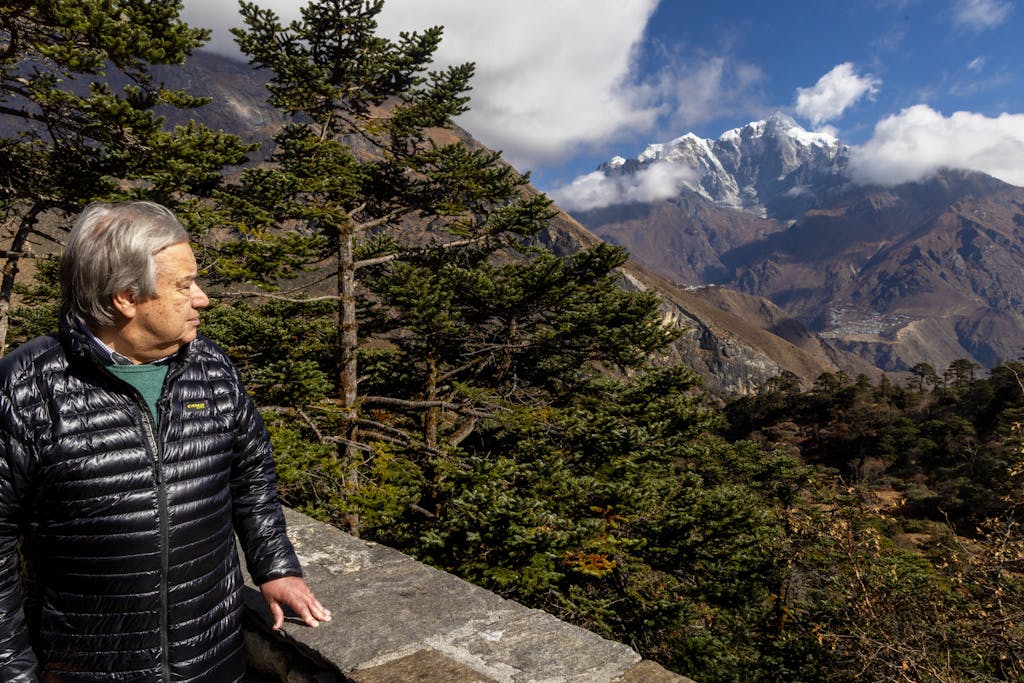
UN Secretary-General António Guterres visits the Everest region in Nepal in late 2023. While there, he called for an end to fossil fuels and underscored the urgency of limiting global temperature rise to 1.5℃ degrees in order to avoid the worst impacts of the climate crisis. Photo: UN Photo/Narendra Shrestha
THE UN’S NEXT CHAPTER STARTS NOW
Next year the UN turns 80. It’s time for bold reforms. This year’s UNGA offers a pivotal platform to drive collective action toward a better world, but we all need to pay attention — and heed the calls from young people to act now.
“A lot of the energy and determination to plan for the future is coming from the next generation,” Dharmadasa says. “But that energy — that fire — is finite. It can be extinguished. We can’t rely on young people to keep fueling our energy to act. We really need the UN to help bring us together.”
When heads of state convene in New York this September, they can turn the page on global cooperation and start a new chapter in the UN’s nearly 80-year story.
“The United Nations was founded for ‘We, the Peoples,’” Inés says, referring to the opening lines of the institution’s founding charter. “If people believe that the future of humanity matters, then this UNGA matters.”
“If people believe that the future of humanity matters, then this UNGA matters.”
Inés Yábar, Lead Next Generation Fellow
Prachi agrees. “UNGA isn’t just a place where governments gather to have high-level discussions that are beyond us,” she says. “It is about us as ordinary citizens. It’s about our present and our future. The decisions being made there ultimately impact our day-to-day lives.
“I hope people stop looking at UNGA as this glamorous unicorn from a faraway land beyond our reach that’s supposed to magically solve all our problems. It’s part of us.”
Dynahlee Padilla-Vasquez, Communications Officer, contributed to this article.
JOIN THE ACTION AT UNGA 79
Whether online or in person, you can get involved with UNGA 79. Visit the UN Foundation’s hub to get the latest updates — plus details on events you don’t want to miss, including the Summit of the Future.

